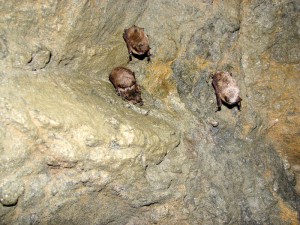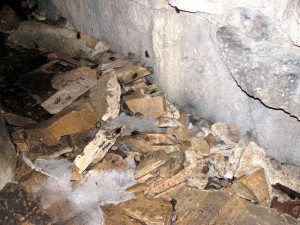In a previous post, I wrote about White-Nose Syndrome (WNS) in hibernating bats in North America. WNS was first documented on February 2006, by a recreational caver exploring Howes Cave in New York, who photographed a bat with an unusual white growth on its muzzle. In the few years since that picture was snapped, hundreds of thousands of bats in North America have died from White-Nose Syndrome (1,2).
Suffering bats are emaciated with little or no body fat and have a characteristic white fungal growth on their wing membranes, ears and muzzles. Instead of hibernating all winter, these bats can be seen active in the snow, when there is virtually no food available for them (1,2).
The white fungal growth observed on the bats is the result of infection with a cold-loving fungus, which has been identified as a new species within the Geomyces genus, Geomyces destructans (note added in 2016: this fungus is now called Pseudogymnoascus destructans) (1,3). Analysis of G. destructans samples suggests that the bats have been infected with G. destructans originating from a single source (3).
So far, according to Dr. David Blehert at the United States Geological Survey (USGS) – National Wildlife Health Center, no data indicate that there is any other etiologic agent at play here. G. destructans is the primary suspect. G. destructans has been found on hibernating bats in caves in Germany, France, Hungary, and Switzerland. However the affected bats in Europe are not emaciated, and those affected bats that were tracked after the initial isolation remained healthy (4). As far as scientists can tell, the European and North American isolates of G. destructans are the same.
In a new opinion paper published in BMC Biology, Cryan and colleagues put forth several hypotheses about how infection with G. destructans could cause the mortality observed in the North American bat populations (5).
Although, to the casual observer, the most obvious manifestation of WNS is the characteristic white fungal growth on the muzzle from which the syndrome derives its name, the real damage to the bats may actually result from what the G. destructans infection does to the wing.
Bats have significantly more exposed skin membrane along their “wings” (stretching from their digits, along their arms to the tail) than on other parts of their body. Because of this, the skin membrane of the wings plays an important role in maintaining homeostatsis. Disruption of these membranes by fungal infections could have devastating consequences for the hibernating bats.
The wings of WNS-affected bats are often brittle, tearing easily, with folded surfaces sticking to each other, instead of retaining their typical elastic tone. G. destructans can erode the skin creating cup-like pits filled with fungal hyphae, and they can destroy apocrine glands, hair follicles and sebaceous glands in the wing membranes. Invading fungus also appears to replace connective tissue, blood and lymphatic vessels of the wing as the colonies expand.
Although the damage is limited to the skin, and there isn’t any evidence to suggest that G. destructans invades blood vessels or sets up conditions for secondary infectious agents, according to the authors, this skin damage to the bat wing may well be sufficient to explain the observed mortality.
The wing membrane is critical for maintaining water balance and preventing dehydration during hibernation in bats. Their large lungs and exposed wing membranes subject bats to a great deal of evaporative water loss (EWL), and up to 99% of total water loss in a healthy hibernating bat can be tracked to losses from skin alone. To help compensate for EWL, most bats hibernate in areas of high humidity (cold, humid conditions ironically are also the perfect conditions for growth of G. destructans). Loss of the integrity of the wing membrane as a result of G. destructans infection could well disrupt fluid regulation in the wing, causing them to be subject to increased dehydration. Further since G. destructans disrupts the oil secreting glands of the wing membrane, it is also disrupting the waterproofing and moisturizing mechanism of this surface. Necropsy of WNS-affected bats indicates dehydration is a factor in mortality.
WNS-affected bats are also emaciated. One possible reason for this is that they are emerging from their stupor too early or too often. One hypothesis for the arousal from hibernation in healthy bats is the need to drink water to restore water balance. WNS-affected bats have been observed emerging often from caves in mid winter. Perhaps these aberrant mid-winter flights are the result of thirst. Excessive thirst-arousals from hibernation would deplete fat stores and lead to emaciation.
The authors also propose that the damage to the wing membrane tissue may also disrupt circulation and skin-mediated gas exchange. The blood-gas barrier in the wing is thin, and even in hibernating bats with folded wings, gas exchange across the wing membrane has been documented. Another side effect of damage to the wing skin and vasculature is disruption of thermoregulation, if warmed blood reaches the peripheral tissues and doesn’t remain restricted to the body core.
Finally, the authors point out the most obvious effect of wing damage, reduced ability to fly. Affected bats aroused from torpor have been observed to wing-walk on snow and be unable to fly.
The authors of this paper have presented several testable hypotheses as to how infection with G. destructans may be responsible for the mortality observed in WNS-affected populations in North America. Understanding the pathology of the infection is the first step in understanding how to control it.
Losses of bat populations over the last few years are staggering. Bats are key species in forest and cave ecosystems. They are plant pollinators and consume a significant volume of nighttime insects. Additionally bats bring nutrients into the relatively isolated ecosystems of caves. It may be that Nature will have to restore a new balance to the cave ecosystems, and only time will tell what that balance will look like. One thing is certain, with a 75% decline in bat populations over a two-year period, that new balance will look very different from the old one. In the mean time, we’ve got a lot to learn.
References
- Blehert, D. et al. (2009) Bat White-Nose Syndrome: An Emerging Fungal Pathogen? Science 323, 227.
- National Wildlife Health Center. White Nose Syndrome. [Internet] United States Geological Survey. Accessed: 28 October 2010. http://www.nwhc.usgs.gov/disease_information/white-nose_syndrome/
- Chaturvedi, V. et al. (2010) Morphological and Molecular Characterizations of Psychrophilic Fungus Geomyces destructans from New York Bats with White Nose Syndrome (WNS) PLoS ONE 5, e10783.
- Wibbelt, G. et al. (2010) White-Nose Syndrome Fungus (Geomyces destructans) in Bats, Europe. Emerging Infectious Diseases 16, 1237-42.
Literature Reviewed
Cryan, P., Meteyer, C., Boyles, J., & Blehert, D. (2010). Wing pathology of white-nose syndrome in bats suggests life-threatening disruption of physiology BMC Biology, 8 (1) DOI: 10.1186/1741-7007-8-135
Michele Arduengo
Latest posts by Michele Arduengo (see all)
- Automated Sampling and Detection of ToBRFV: An Emerging Tomato Virus - April 25, 2024
- On-site, In-house Environmental Monitoring to Obtain Species-Level Microbial Identification - August 28, 2023
- 2023 Promega iGEM Grant Winners: Tackling Global Problems with Synthetic Biology Solutions - July 5, 2023



This is interesting. In looking at the paper (and references), it seems that bats can get a significant fraction (~10%) of their O2 through gas exchange with their wings. I would think that would be plenty for during hibernation. Not breathing would greatly reduce H2O loss. If wing damage prevented that O2/CO2 gas exchange and forced them to breathe, that could be what causes the H2O loss. It might be the breathing that fosters the growth of the mold on their noses.
Yes, bats do seem to accomplish a significant amount of gas exchange via transpiration over wing surfaces, and as one of the paper’s references suggested, even though this is reduced when the wings are folded for hibernation, it can still be significant. The authors also make the point that if the bats are breathing more they could be losing water from the lungs. Interesting thought that this water loss around the muzzle might also create a perfect microenvironment for fungal growth. Thanks for you comment.
Michele
Michele, did you see this news?
http://www.bbc.co.uk/news/science-environment-13438594
From a WNS conference in Arkansas this week. Let’s hope it works!
Hi Kari,
Yes I did. Right now the plan mostly establishes the required infrastructure for acting quickly should any breakthrough in “treatment” or “prevention” be developed. Efforts to monitor and notify of spread will be more coordinated, and it sounds like they will be investigating things like raising captive populations in an effort to maintain/restore a genetically viable bat population. They clearly recognize how important protecting bat habitat will be, so it’s nice to see some mobilization on that front. I just wish they had a real break through on control or treatment.
Michele